Health Economics: Study Material with Solved Assignments
VerifiedAdded on 2023/06/10
|12
|3999
|92
AI Summary
This study material covers various topics related to Health Economics including technical efficiency, cost-utility analysis, QALYs, ICER, and more. It also includes solved assignments and essays. The course code covered is MMB725020.
Contribute Materials
Your contribution can guide someone’s learning journey. Share your
documents today.
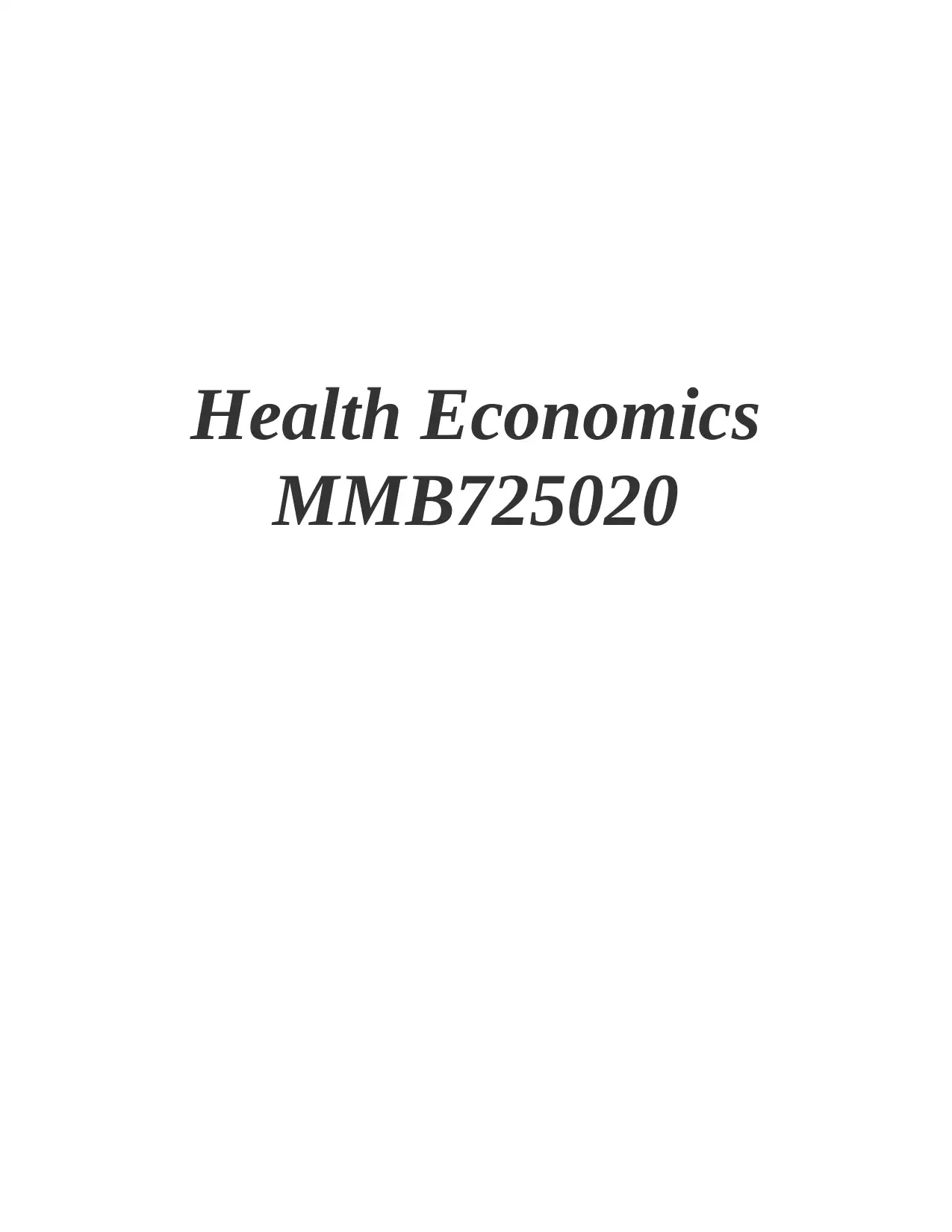
Health Economics
MMB725020
MMB725020
Secure Best Marks with AI Grader
Need help grading? Try our AI Grader for instant feedback on your assignments.
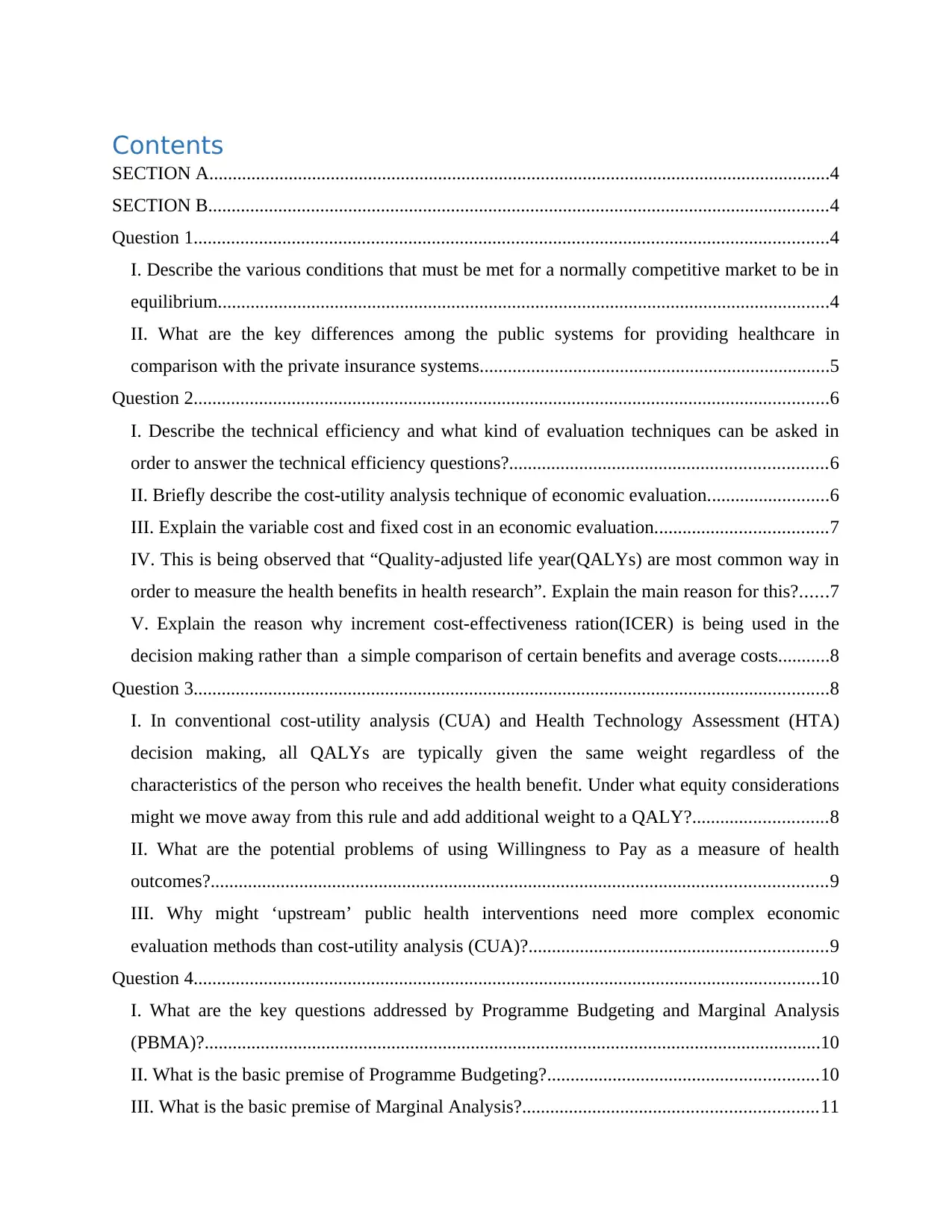
Contents
SECTION A.....................................................................................................................................4
SECTION B.....................................................................................................................................4
Question 1........................................................................................................................................4
I. Describe the various conditions that must be met for a normally competitive market to be in
equilibrium...................................................................................................................................4
II. What are the key differences among the public systems for providing healthcare in
comparison with the private insurance systems...........................................................................5
Question 2........................................................................................................................................6
I. Describe the technical efficiency and what kind of evaluation techniques can be asked in
order to answer the technical efficiency questions?....................................................................6
II. Briefly describe the cost-utility analysis technique of economic evaluation..........................6
III. Explain the variable cost and fixed cost in an economic evaluation.....................................7
IV. This is being observed that “Quality-adjusted life year(QALYs) are most common way in
order to measure the health benefits in health research”. Explain the main reason for this?......7
V. Explain the reason why increment cost-effectiveness ration(ICER) is being used in the
decision making rather than a simple comparison of certain benefits and average costs...........8
Question 3........................................................................................................................................8
I. In conventional cost-utility analysis (CUA) and Health Technology Assessment (HTA)
decision making, all QALYs are typically given the same weight regardless of the
characteristics of the person who receives the health benefit. Under what equity considerations
might we move away from this rule and add additional weight to a QALY?.............................8
II. What are the potential problems of using Willingness to Pay as a measure of health
outcomes?....................................................................................................................................9
III. Why might ‘upstream’ public health interventions need more complex economic
evaluation methods than cost-utility analysis (CUA)?................................................................9
Question 4......................................................................................................................................10
I. What are the key questions addressed by Programme Budgeting and Marginal Analysis
(PBMA)?....................................................................................................................................10
II. What is the basic premise of Programme Budgeting?..........................................................10
III. What is the basic premise of Marginal Analysis?...............................................................11
SECTION A.....................................................................................................................................4
SECTION B.....................................................................................................................................4
Question 1........................................................................................................................................4
I. Describe the various conditions that must be met for a normally competitive market to be in
equilibrium...................................................................................................................................4
II. What are the key differences among the public systems for providing healthcare in
comparison with the private insurance systems...........................................................................5
Question 2........................................................................................................................................6
I. Describe the technical efficiency and what kind of evaluation techniques can be asked in
order to answer the technical efficiency questions?....................................................................6
II. Briefly describe the cost-utility analysis technique of economic evaluation..........................6
III. Explain the variable cost and fixed cost in an economic evaluation.....................................7
IV. This is being observed that “Quality-adjusted life year(QALYs) are most common way in
order to measure the health benefits in health research”. Explain the main reason for this?......7
V. Explain the reason why increment cost-effectiveness ration(ICER) is being used in the
decision making rather than a simple comparison of certain benefits and average costs...........8
Question 3........................................................................................................................................8
I. In conventional cost-utility analysis (CUA) and Health Technology Assessment (HTA)
decision making, all QALYs are typically given the same weight regardless of the
characteristics of the person who receives the health benefit. Under what equity considerations
might we move away from this rule and add additional weight to a QALY?.............................8
II. What are the potential problems of using Willingness to Pay as a measure of health
outcomes?....................................................................................................................................9
III. Why might ‘upstream’ public health interventions need more complex economic
evaluation methods than cost-utility analysis (CUA)?................................................................9
Question 4......................................................................................................................................10
I. What are the key questions addressed by Programme Budgeting and Marginal Analysis
(PBMA)?....................................................................................................................................10
II. What is the basic premise of Programme Budgeting?..........................................................10
III. What is the basic premise of Marginal Analysis?...............................................................11
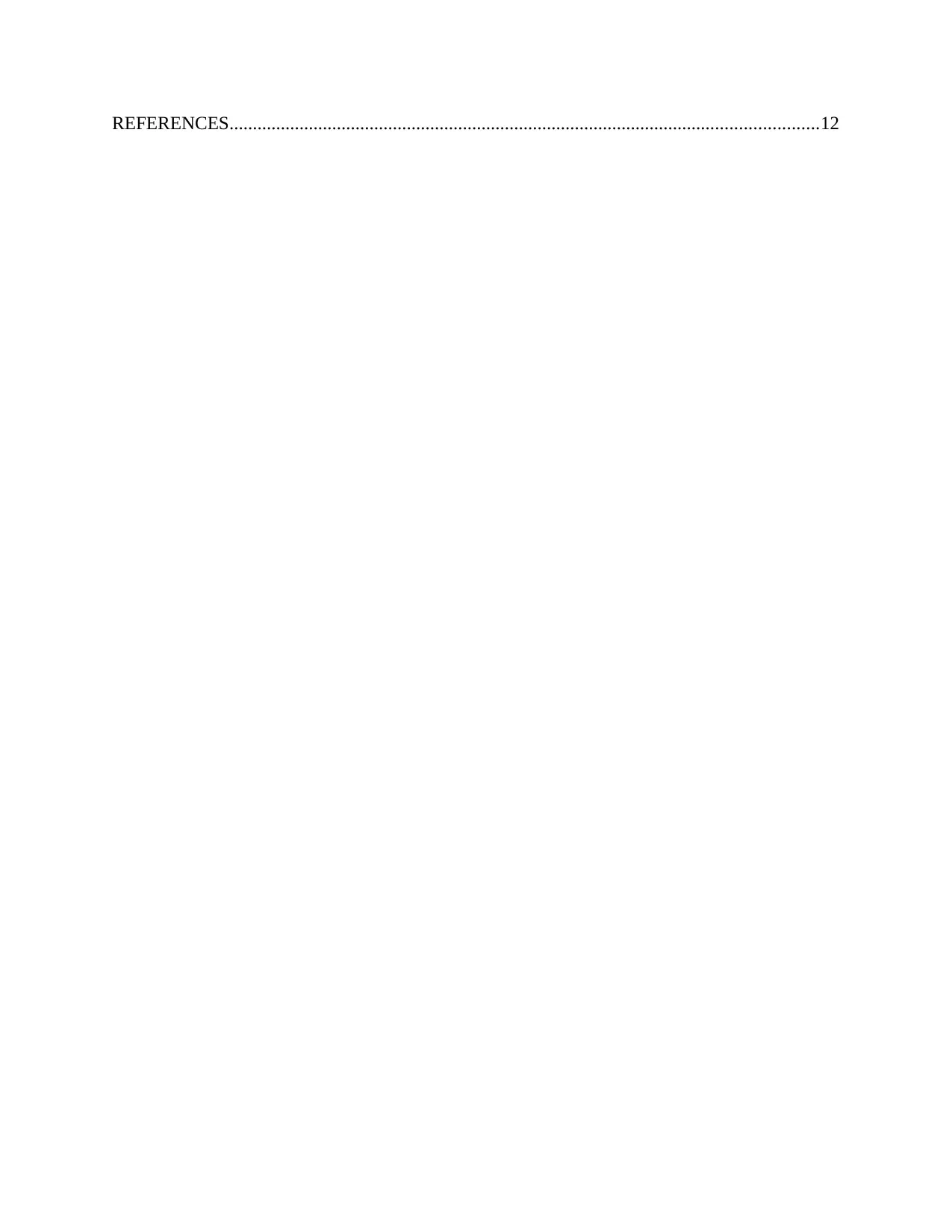
REFERENCES..............................................................................................................................12
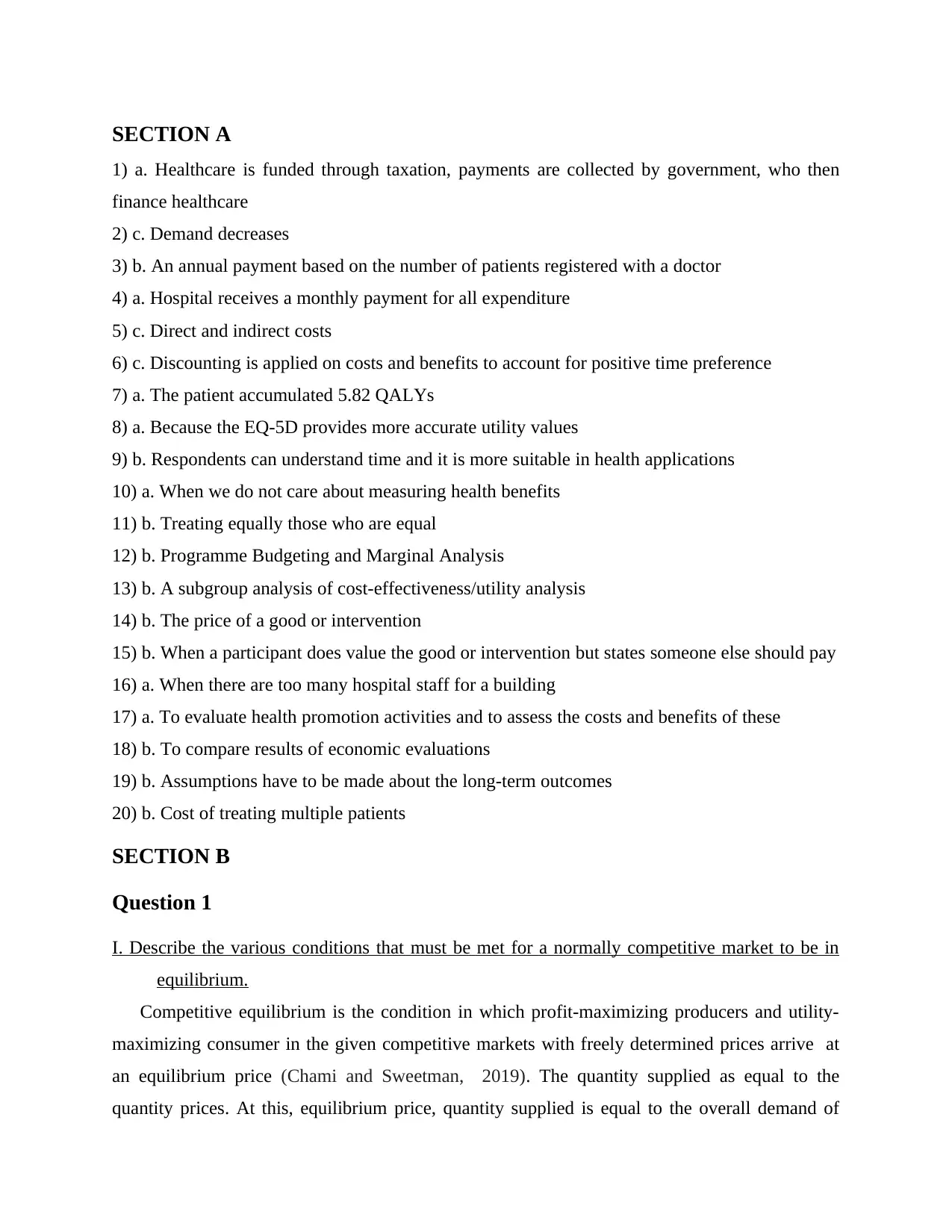
SECTION A
1) a. Healthcare is funded through taxation, payments are collected by government, who then
finance healthcare
2) c. Demand decreases
3) b. An annual payment based on the number of patients registered with a doctor
4) a. Hospital receives a monthly payment for all expenditure
5) c. Direct and indirect costs
6) c. Discounting is applied on costs and benefits to account for positive time preference
7) a. The patient accumulated 5.82 QALYs
8) a. Because the EQ-5D provides more accurate utility values
9) b. Respondents can understand time and it is more suitable in health applications
10) a. When we do not care about measuring health benefits
11) b. Treating equally those who are equal
12) b. Programme Budgeting and Marginal Analysis
13) b. A subgroup analysis of cost-effectiveness/utility analysis
14) b. The price of a good or intervention
15) b. When a participant does value the good or intervention but states someone else should pay
16) a. When there are too many hospital staff for a building
17) a. To evaluate health promotion activities and to assess the costs and benefits of these
18) b. To compare results of economic evaluations
19) b. Assumptions have to be made about the long-term outcomes
20) b. Cost of treating multiple patients
SECTION B
Question 1
I. Describe the various conditions that must be met for a normally competitive market to be in
equilibrium.
Competitive equilibrium is the condition in which profit-maximizing producers and utility-
maximizing consumer in the given competitive markets with freely determined prices arrive at
an equilibrium price (Chami and Sweetman, 2019). The quantity supplied as equal to the
quantity prices. At this, equilibrium price, quantity supplied is equal to the overall demand of
1) a. Healthcare is funded through taxation, payments are collected by government, who then
finance healthcare
2) c. Demand decreases
3) b. An annual payment based on the number of patients registered with a doctor
4) a. Hospital receives a monthly payment for all expenditure
5) c. Direct and indirect costs
6) c. Discounting is applied on costs and benefits to account for positive time preference
7) a. The patient accumulated 5.82 QALYs
8) a. Because the EQ-5D provides more accurate utility values
9) b. Respondents can understand time and it is more suitable in health applications
10) a. When we do not care about measuring health benefits
11) b. Treating equally those who are equal
12) b. Programme Budgeting and Marginal Analysis
13) b. A subgroup analysis of cost-effectiveness/utility analysis
14) b. The price of a good or intervention
15) b. When a participant does value the good or intervention but states someone else should pay
16) a. When there are too many hospital staff for a building
17) a. To evaluate health promotion activities and to assess the costs and benefits of these
18) b. To compare results of economic evaluations
19) b. Assumptions have to be made about the long-term outcomes
20) b. Cost of treating multiple patients
SECTION B
Question 1
I. Describe the various conditions that must be met for a normally competitive market to be in
equilibrium.
Competitive equilibrium is the condition in which profit-maximizing producers and utility-
maximizing consumer in the given competitive markets with freely determined prices arrive at
an equilibrium price (Chami and Sweetman, 2019). The quantity supplied as equal to the
quantity prices. At this, equilibrium price, quantity supplied is equal to the overall demand of
Secure Best Marks with AI Grader
Need help grading? Try our AI Grader for instant feedback on your assignments.
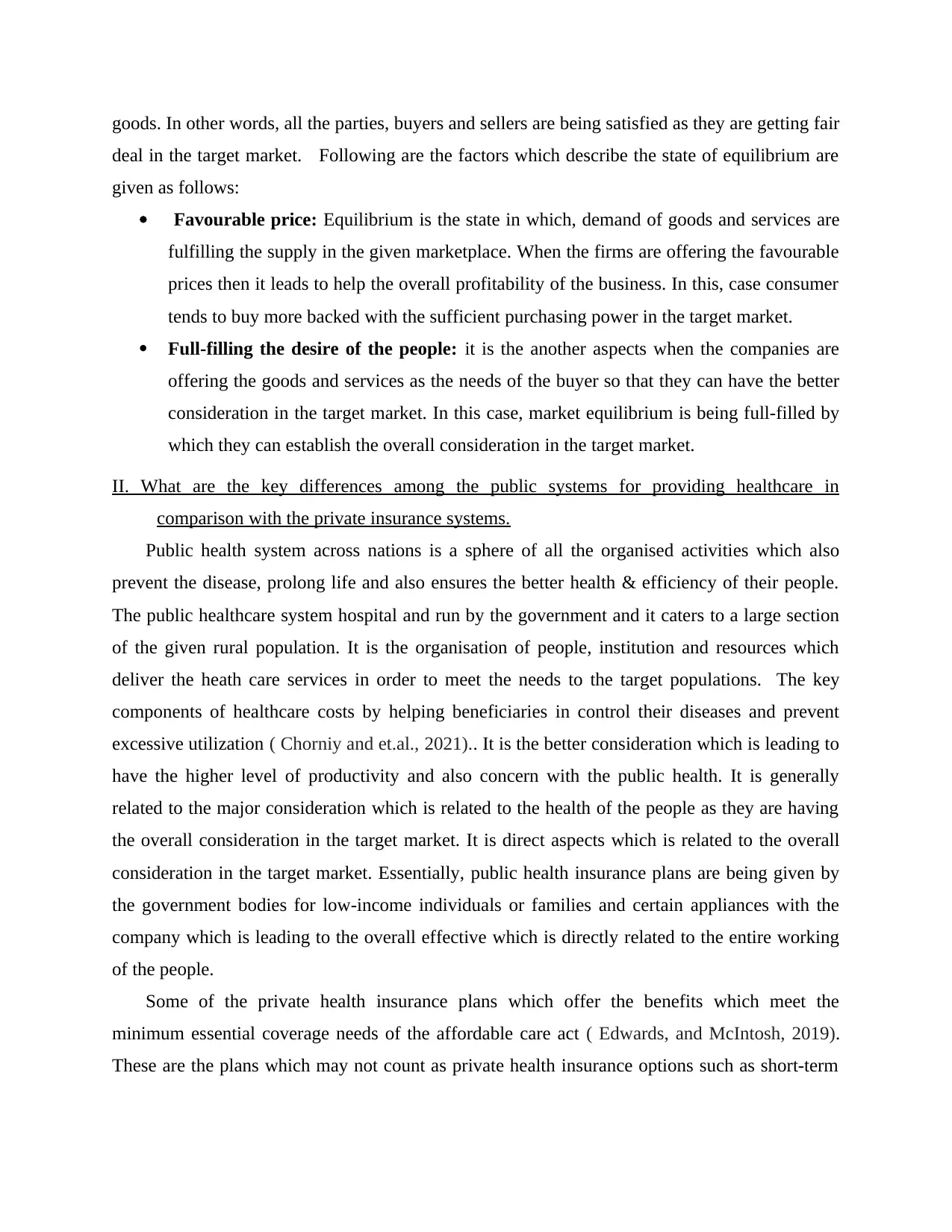
goods. In other words, all the parties, buyers and sellers are being satisfied as they are getting fair
deal in the target market. Following are the factors which describe the state of equilibrium are
given as follows:
Favourable price: Equilibrium is the state in which, demand of goods and services are
fulfilling the supply in the given marketplace. When the firms are offering the favourable
prices then it leads to help the overall profitability of the business. In this, case consumer
tends to buy more backed with the sufficient purchasing power in the target market.
Full-filling the desire of the people: it is the another aspects when the companies are
offering the goods and services as the needs of the buyer so that they can have the better
consideration in the target market. In this case, market equilibrium is being full-filled by
which they can establish the overall consideration in the target market.
II. What are the key differences among the public systems for providing healthcare in
comparison with the private insurance systems.
Public health system across nations is a sphere of all the organised activities which also
prevent the disease, prolong life and also ensures the better health & efficiency of their people.
The public healthcare system hospital and run by the government and it caters to a large section
of the given rural population. It is the organisation of people, institution and resources which
deliver the heath care services in order to meet the needs to the target populations. The key
components of healthcare costs by helping beneficiaries in control their diseases and prevent
excessive utilization ( Chorniy and et.al., 2021).. It is the better consideration which is leading to
have the higher level of productivity and also concern with the public health. It is generally
related to the major consideration which is related to the health of the people as they are having
the overall consideration in the target market. It is direct aspects which is related to the overall
consideration in the target market. Essentially, public health insurance plans are being given by
the government bodies for low-income individuals or families and certain appliances with the
company which is leading to the overall effective which is directly related to the entire working
of the people.
Some of the private health insurance plans which offer the benefits which meet the
minimum essential coverage needs of the affordable care act ( Edwards, and McIntosh, 2019).
These are the plans which may not count as private health insurance options such as short-term
deal in the target market. Following are the factors which describe the state of equilibrium are
given as follows:
Favourable price: Equilibrium is the state in which, demand of goods and services are
fulfilling the supply in the given marketplace. When the firms are offering the favourable
prices then it leads to help the overall profitability of the business. In this, case consumer
tends to buy more backed with the sufficient purchasing power in the target market.
Full-filling the desire of the people: it is the another aspects when the companies are
offering the goods and services as the needs of the buyer so that they can have the better
consideration in the target market. In this case, market equilibrium is being full-filled by
which they can establish the overall consideration in the target market.
II. What are the key differences among the public systems for providing healthcare in
comparison with the private insurance systems.
Public health system across nations is a sphere of all the organised activities which also
prevent the disease, prolong life and also ensures the better health & efficiency of their people.
The public healthcare system hospital and run by the government and it caters to a large section
of the given rural population. It is the organisation of people, institution and resources which
deliver the heath care services in order to meet the needs to the target populations. The key
components of healthcare costs by helping beneficiaries in control their diseases and prevent
excessive utilization ( Chorniy and et.al., 2021).. It is the better consideration which is leading to
have the higher level of productivity and also concern with the public health. It is generally
related to the major consideration which is related to the health of the people as they are having
the overall consideration in the target market. It is direct aspects which is related to the overall
consideration in the target market. Essentially, public health insurance plans are being given by
the government bodies for low-income individuals or families and certain appliances with the
company which is leading to the overall effective which is directly related to the entire working
of the people.
Some of the private health insurance plans which offer the benefits which meet the
minimum essential coverage needs of the affordable care act ( Edwards, and McIntosh, 2019).
These are the plans which may not count as private health insurance options such as short-term
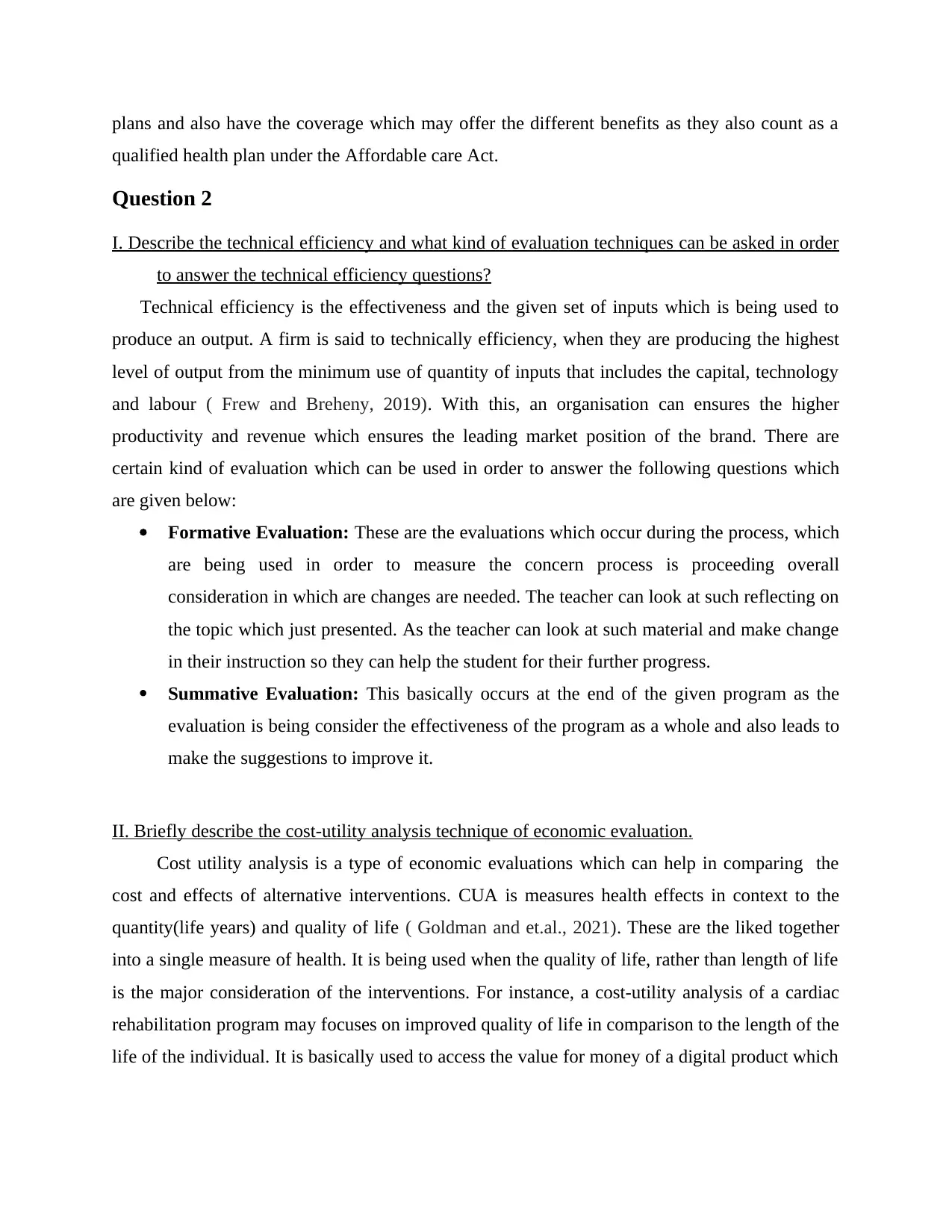
plans and also have the coverage which may offer the different benefits as they also count as a
qualified health plan under the Affordable care Act.
Question 2
I. Describe the technical efficiency and what kind of evaluation techniques can be asked in order
to answer the technical efficiency questions?
Technical efficiency is the effectiveness and the given set of inputs which is being used to
produce an output. A firm is said to technically efficiency, when they are producing the highest
level of output from the minimum use of quantity of inputs that includes the capital, technology
and labour ( Frew and Breheny, 2019). With this, an organisation can ensures the higher
productivity and revenue which ensures the leading market position of the brand. There are
certain kind of evaluation which can be used in order to answer the following questions which
are given below:
Formative Evaluation: These are the evaluations which occur during the process, which
are being used in order to measure the concern process is proceeding overall
consideration in which are changes are needed. The teacher can look at such reflecting on
the topic which just presented. As the teacher can look at such material and make change
in their instruction so they can help the student for their further progress.
Summative Evaluation: This basically occurs at the end of the given program as the
evaluation is being consider the effectiveness of the program as a whole and also leads to
make the suggestions to improve it.
II. Briefly describe the cost-utility analysis technique of economic evaluation.
Cost utility analysis is a type of economic evaluations which can help in comparing the
cost and effects of alternative interventions. CUA is measures health effects in context to the
quantity(life years) and quality of life ( Goldman and et.al., 2021). These are the liked together
into a single measure of health. It is being used when the quality of life, rather than length of life
is the major consideration of the interventions. For instance, a cost-utility analysis of a cardiac
rehabilitation program may focuses on improved quality of life in comparison to the length of the
life of the individual. It is basically used to access the value for money of a digital product which
qualified health plan under the Affordable care Act.
Question 2
I. Describe the technical efficiency and what kind of evaluation techniques can be asked in order
to answer the technical efficiency questions?
Technical efficiency is the effectiveness and the given set of inputs which is being used to
produce an output. A firm is said to technically efficiency, when they are producing the highest
level of output from the minimum use of quantity of inputs that includes the capital, technology
and labour ( Frew and Breheny, 2019). With this, an organisation can ensures the higher
productivity and revenue which ensures the leading market position of the brand. There are
certain kind of evaluation which can be used in order to answer the following questions which
are given below:
Formative Evaluation: These are the evaluations which occur during the process, which
are being used in order to measure the concern process is proceeding overall
consideration in which are changes are needed. The teacher can look at such reflecting on
the topic which just presented. As the teacher can look at such material and make change
in their instruction so they can help the student for their further progress.
Summative Evaluation: This basically occurs at the end of the given program as the
evaluation is being consider the effectiveness of the program as a whole and also leads to
make the suggestions to improve it.
II. Briefly describe the cost-utility analysis technique of economic evaluation.
Cost utility analysis is a type of economic evaluations which can help in comparing the
cost and effects of alternative interventions. CUA is measures health effects in context to the
quantity(life years) and quality of life ( Goldman and et.al., 2021). These are the liked together
into a single measure of health. It is being used when the quality of life, rather than length of life
is the major consideration of the interventions. For instance, a cost-utility analysis of a cardiac
rehabilitation program may focuses on improved quality of life in comparison to the length of the
life of the individual. It is basically used to access the value for money of a digital product which
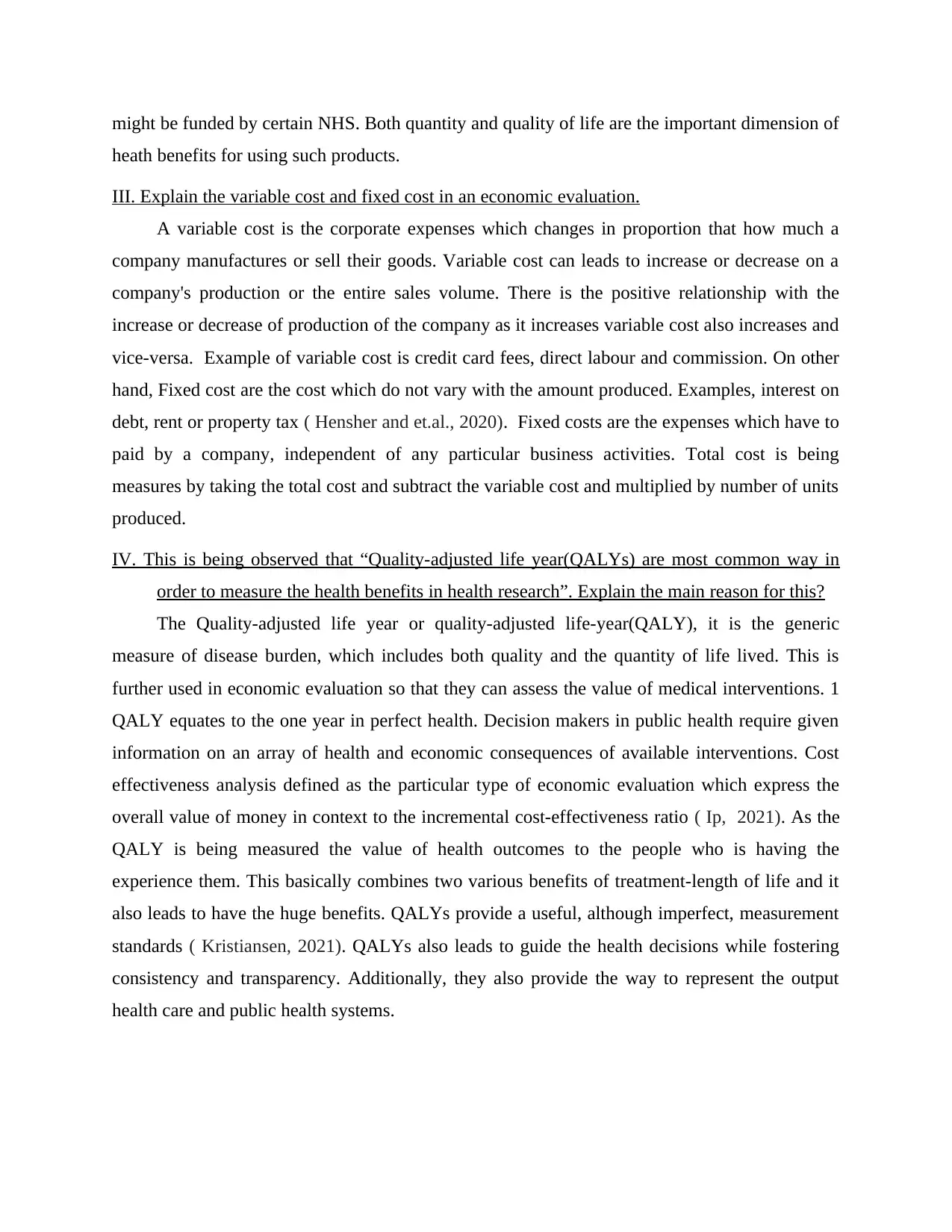
might be funded by certain NHS. Both quantity and quality of life are the important dimension of
heath benefits for using such products.
III. Explain the variable cost and fixed cost in an economic evaluation.
A variable cost is the corporate expenses which changes in proportion that how much a
company manufactures or sell their goods. Variable cost can leads to increase or decrease on a
company's production or the entire sales volume. There is the positive relationship with the
increase or decrease of production of the company as it increases variable cost also increases and
vice-versa. Example of variable cost is credit card fees, direct labour and commission. On other
hand, Fixed cost are the cost which do not vary with the amount produced. Examples, interest on
debt, rent or property tax ( Hensher and et.al., 2020). Fixed costs are the expenses which have to
paid by a company, independent of any particular business activities. Total cost is being
measures by taking the total cost and subtract the variable cost and multiplied by number of units
produced.
IV. This is being observed that “Quality-adjusted life year(QALYs) are most common way in
order to measure the health benefits in health research”. Explain the main reason for this?
The Quality-adjusted life year or quality-adjusted life-year(QALY), it is the generic
measure of disease burden, which includes both quality and the quantity of life lived. This is
further used in economic evaluation so that they can assess the value of medical interventions. 1
QALY equates to the one year in perfect health. Decision makers in public health require given
information on an array of health and economic consequences of available interventions. Cost
effectiveness analysis defined as the particular type of economic evaluation which express the
overall value of money in context to the incremental cost-effectiveness ratio ( Ip, 2021). As the
QALY is being measured the value of health outcomes to the people who is having the
experience them. This basically combines two various benefits of treatment-length of life and it
also leads to have the huge benefits. QALYs provide a useful, although imperfect, measurement
standards ( Kristiansen, 2021). QALYs also leads to guide the health decisions while fostering
consistency and transparency. Additionally, they also provide the way to represent the output
health care and public health systems.
heath benefits for using such products.
III. Explain the variable cost and fixed cost in an economic evaluation.
A variable cost is the corporate expenses which changes in proportion that how much a
company manufactures or sell their goods. Variable cost can leads to increase or decrease on a
company's production or the entire sales volume. There is the positive relationship with the
increase or decrease of production of the company as it increases variable cost also increases and
vice-versa. Example of variable cost is credit card fees, direct labour and commission. On other
hand, Fixed cost are the cost which do not vary with the amount produced. Examples, interest on
debt, rent or property tax ( Hensher and et.al., 2020). Fixed costs are the expenses which have to
paid by a company, independent of any particular business activities. Total cost is being
measures by taking the total cost and subtract the variable cost and multiplied by number of units
produced.
IV. This is being observed that “Quality-adjusted life year(QALYs) are most common way in
order to measure the health benefits in health research”. Explain the main reason for this?
The Quality-adjusted life year or quality-adjusted life-year(QALY), it is the generic
measure of disease burden, which includes both quality and the quantity of life lived. This is
further used in economic evaluation so that they can assess the value of medical interventions. 1
QALY equates to the one year in perfect health. Decision makers in public health require given
information on an array of health and economic consequences of available interventions. Cost
effectiveness analysis defined as the particular type of economic evaluation which express the
overall value of money in context to the incremental cost-effectiveness ratio ( Ip, 2021). As the
QALY is being measured the value of health outcomes to the people who is having the
experience them. This basically combines two various benefits of treatment-length of life and it
also leads to have the huge benefits. QALYs provide a useful, although imperfect, measurement
standards ( Kristiansen, 2021). QALYs also leads to guide the health decisions while fostering
consistency and transparency. Additionally, they also provide the way to represent the output
health care and public health systems.
Paraphrase This Document
Need a fresh take? Get an instant paraphrase of this document with our AI Paraphraser
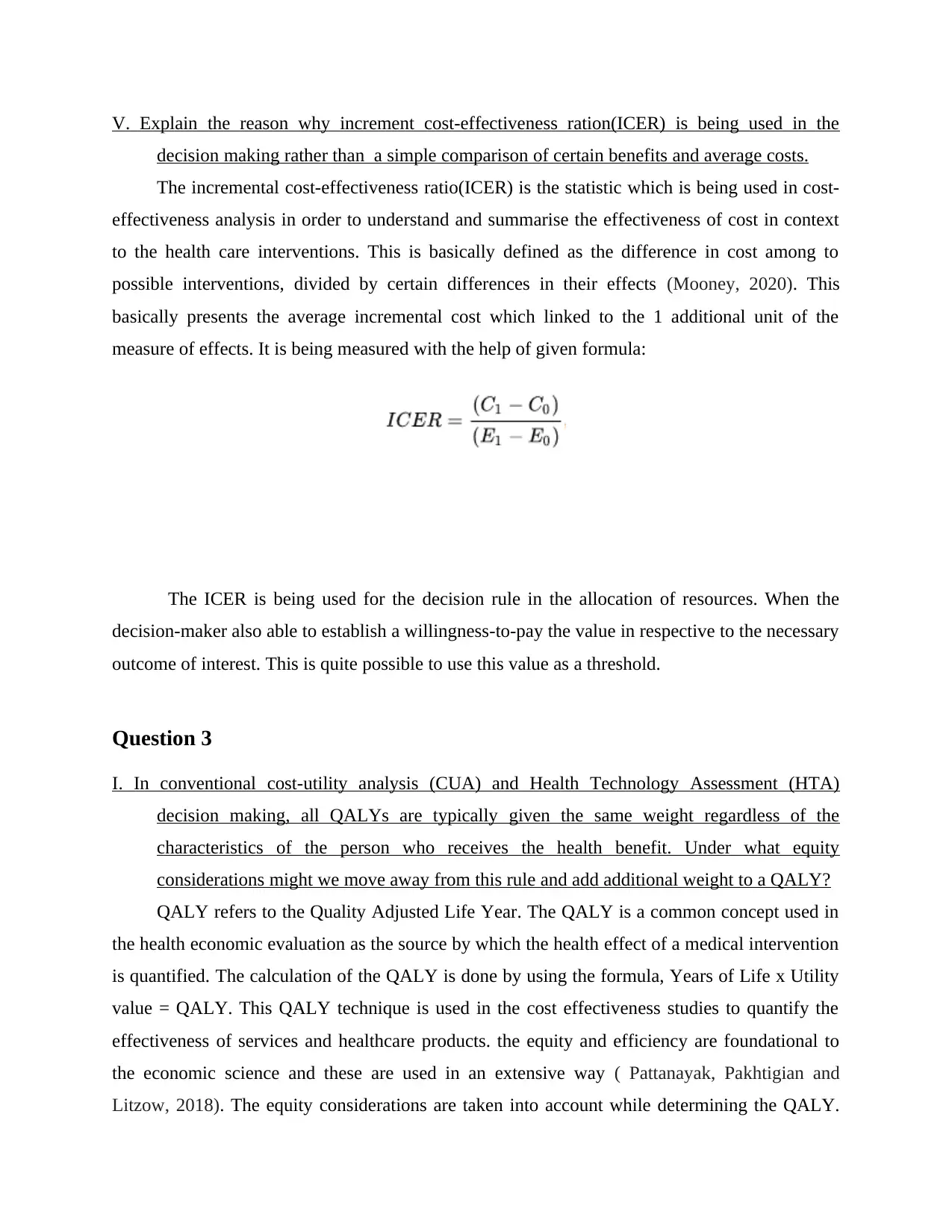
V. Explain the reason why increment cost-effectiveness ration(ICER) is being used in the
decision making rather than a simple comparison of certain benefits and average costs.
The incremental cost-effectiveness ratio(ICER) is the statistic which is being used in cost-
effectiveness analysis in order to understand and summarise the effectiveness of cost in context
to the health care interventions. This is basically defined as the difference in cost among to
possible interventions, divided by certain differences in their effects (Mooney, 2020). This
basically presents the average incremental cost which linked to the 1 additional unit of the
measure of effects. It is being measured with the help of given formula:
The ICER is being used for the decision rule in the allocation of resources. When the
decision-maker also able to establish a willingness-to-pay the value in respective to the necessary
outcome of interest. This is quite possible to use this value as a threshold.
Question 3
I. In conventional cost-utility analysis (CUA) and Health Technology Assessment (HTA)
decision making, all QALYs are typically given the same weight regardless of the
characteristics of the person who receives the health benefit. Under what equity
considerations might we move away from this rule and add additional weight to a QALY?
QALY refers to the Quality Adjusted Life Year. The QALY is a common concept used in
the health economic evaluation as the source by which the health effect of a medical intervention
is quantified. The calculation of the QALY is done by using the formula, Years of Life x Utility
value = QALY. This QALY technique is used in the cost effectiveness studies to quantify the
effectiveness of services and healthcare products. the equity and efficiency are foundational to
the economic science and these are used in an extensive way ( Pattanayak, Pakhtigian and
Litzow, 2018). The equity considerations are taken into account while determining the QALY.
decision making rather than a simple comparison of certain benefits and average costs.
The incremental cost-effectiveness ratio(ICER) is the statistic which is being used in cost-
effectiveness analysis in order to understand and summarise the effectiveness of cost in context
to the health care interventions. This is basically defined as the difference in cost among to
possible interventions, divided by certain differences in their effects (Mooney, 2020). This
basically presents the average incremental cost which linked to the 1 additional unit of the
measure of effects. It is being measured with the help of given formula:
The ICER is being used for the decision rule in the allocation of resources. When the
decision-maker also able to establish a willingness-to-pay the value in respective to the necessary
outcome of interest. This is quite possible to use this value as a threshold.
Question 3
I. In conventional cost-utility analysis (CUA) and Health Technology Assessment (HTA)
decision making, all QALYs are typically given the same weight regardless of the
characteristics of the person who receives the health benefit. Under what equity
considerations might we move away from this rule and add additional weight to a QALY?
QALY refers to the Quality Adjusted Life Year. The QALY is a common concept used in
the health economic evaluation as the source by which the health effect of a medical intervention
is quantified. The calculation of the QALY is done by using the formula, Years of Life x Utility
value = QALY. This QALY technique is used in the cost effectiveness studies to quantify the
effectiveness of services and healthcare products. the equity and efficiency are foundational to
the economic science and these are used in an extensive way ( Pattanayak, Pakhtigian and
Litzow, 2018). The equity considerations are taken into account while determining the QALY.

Additional weights are added to the QALY regardless of the factors of the person receiving the
health benefit. A special consideration and added weight is provided to the QALY when the
person who is receiving the health benefit is too old or too young. Whenever the age of the
patient is having a higher deviation from the mean of the patients, a special weight is provided to
balance out the population.
II. What are the potential problems of using Willingness to Pay as a measure of health outcomes?
The economic benefits in the health care field are dominated by the different cost- effective
and cost per QALY analysis. The payers of the health care are unwilling to take into
consideration the cost benefit analysis which is based on the Willingness to Pay. The major
problem which is being faced by the health industry is that the payers does not consider this
approach a right one. The other problem is related to the efficiency and the equity which impact
the prices in the health care which in turn influence the willingness and the ability to pay.
Efficiency: in different studies, it is argued that the fees will decrease the use of health
services and overcrowding, a decline in this utilization will create a situation of surplus
and high average costs for the organisation.
Equity: the prepayment mechanism of the organisation should be sensitive to the local
economic conditions of the people and their ability to pay the costs of services.
The ability to pay require a further detailed analysis due to the fact that the payments to the
health care might be related and based on the assets which cause a long term decline in the
household ( Sen and DeLeire, 2018). The improving of quality is yet another challenge in the
willingness to pay for a service as the health care expenditure would rise as the quality improves
for the service, this may not be considered in the willingness to pay.
III. Why might ‘upstream’ public health interventions need more complex economic evaluation
methods than cost-utility analysis (CUA)?
Cost utility analysis is one of the type of economic elevation which help in comparing the
costs and effects of alternative interventions. CUA basically measures the health effects in
context to the both quantity and quality of life. These are combined into a single measure of
health. But public health requires the more complex economic evaluation methods as it basically
helps in the overall efficiency of the health care and also able to have the various benefits to the
health of the people. In this context upstream public health, more complex economic evaluation
is described as follows:
health benefit. A special consideration and added weight is provided to the QALY when the
person who is receiving the health benefit is too old or too young. Whenever the age of the
patient is having a higher deviation from the mean of the patients, a special weight is provided to
balance out the population.
II. What are the potential problems of using Willingness to Pay as a measure of health outcomes?
The economic benefits in the health care field are dominated by the different cost- effective
and cost per QALY analysis. The payers of the health care are unwilling to take into
consideration the cost benefit analysis which is based on the Willingness to Pay. The major
problem which is being faced by the health industry is that the payers does not consider this
approach a right one. The other problem is related to the efficiency and the equity which impact
the prices in the health care which in turn influence the willingness and the ability to pay.
Efficiency: in different studies, it is argued that the fees will decrease the use of health
services and overcrowding, a decline in this utilization will create a situation of surplus
and high average costs for the organisation.
Equity: the prepayment mechanism of the organisation should be sensitive to the local
economic conditions of the people and their ability to pay the costs of services.
The ability to pay require a further detailed analysis due to the fact that the payments to the
health care might be related and based on the assets which cause a long term decline in the
household ( Sen and DeLeire, 2018). The improving of quality is yet another challenge in the
willingness to pay for a service as the health care expenditure would rise as the quality improves
for the service, this may not be considered in the willingness to pay.
III. Why might ‘upstream’ public health interventions need more complex economic evaluation
methods than cost-utility analysis (CUA)?
Cost utility analysis is one of the type of economic elevation which help in comparing the
costs and effects of alternative interventions. CUA basically measures the health effects in
context to the both quantity and quality of life. These are combined into a single measure of
health. But public health requires the more complex economic evaluation methods as it basically
helps in the overall efficiency of the health care and also able to have the various benefits to the
health of the people. In this context upstream public health, more complex economic evaluation
is described as follows:
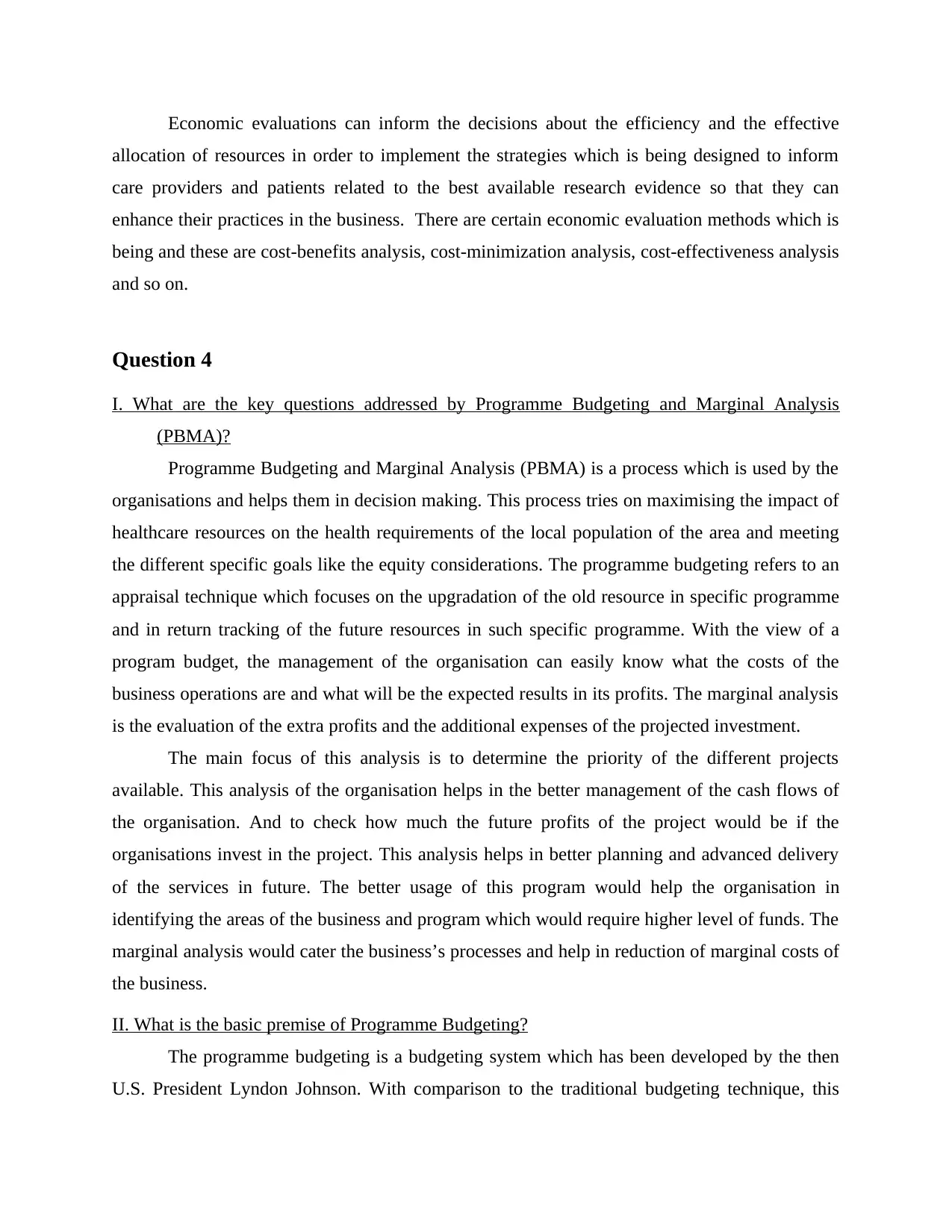
Economic evaluations can inform the decisions about the efficiency and the effective
allocation of resources in order to implement the strategies which is being designed to inform
care providers and patients related to the best available research evidence so that they can
enhance their practices in the business. There are certain economic evaluation methods which is
being and these are cost-benefits analysis, cost-minimization analysis, cost-effectiveness analysis
and so on.
Question 4
I. What are the key questions addressed by Programme Budgeting and Marginal Analysis
(PBMA)?
Programme Budgeting and Marginal Analysis (PBMA) is a process which is used by the
organisations and helps them in decision making. This process tries on maximising the impact of
healthcare resources on the health requirements of the local population of the area and meeting
the different specific goals like the equity considerations. The programme budgeting refers to an
appraisal technique which focuses on the upgradation of the old resource in specific programme
and in return tracking of the future resources in such specific programme. With the view of a
program budget, the management of the organisation can easily know what the costs of the
business operations are and what will be the expected results in its profits. The marginal analysis
is the evaluation of the extra profits and the additional expenses of the projected investment.
The main focus of this analysis is to determine the priority of the different projects
available. This analysis of the organisation helps in the better management of the cash flows of
the organisation. And to check how much the future profits of the project would be if the
organisations invest in the project. This analysis helps in better planning and advanced delivery
of the services in future. The better usage of this program would help the organisation in
identifying the areas of the business and program which would require higher level of funds. The
marginal analysis would cater the business’s processes and help in reduction of marginal costs of
the business.
II. What is the basic premise of Programme Budgeting?
The programme budgeting is a budgeting system which has been developed by the then
U.S. President Lyndon Johnson. With comparison to the traditional budgeting technique, this
allocation of resources in order to implement the strategies which is being designed to inform
care providers and patients related to the best available research evidence so that they can
enhance their practices in the business. There are certain economic evaluation methods which is
being and these are cost-benefits analysis, cost-minimization analysis, cost-effectiveness analysis
and so on.
Question 4
I. What are the key questions addressed by Programme Budgeting and Marginal Analysis
(PBMA)?
Programme Budgeting and Marginal Analysis (PBMA) is a process which is used by the
organisations and helps them in decision making. This process tries on maximising the impact of
healthcare resources on the health requirements of the local population of the area and meeting
the different specific goals like the equity considerations. The programme budgeting refers to an
appraisal technique which focuses on the upgradation of the old resource in specific programme
and in return tracking of the future resources in such specific programme. With the view of a
program budget, the management of the organisation can easily know what the costs of the
business operations are and what will be the expected results in its profits. The marginal analysis
is the evaluation of the extra profits and the additional expenses of the projected investment.
The main focus of this analysis is to determine the priority of the different projects
available. This analysis of the organisation helps in the better management of the cash flows of
the organisation. And to check how much the future profits of the project would be if the
organisations invest in the project. This analysis helps in better planning and advanced delivery
of the services in future. The better usage of this program would help the organisation in
identifying the areas of the business and program which would require higher level of funds. The
marginal analysis would cater the business’s processes and help in reduction of marginal costs of
the business.
II. What is the basic premise of Programme Budgeting?
The programme budgeting is a budgeting system which has been developed by the then
U.S. President Lyndon Johnson. With comparison to the traditional budgeting technique, this
Secure Best Marks with AI Grader
Need help grading? Try our AI Grader for instant feedback on your assignments.
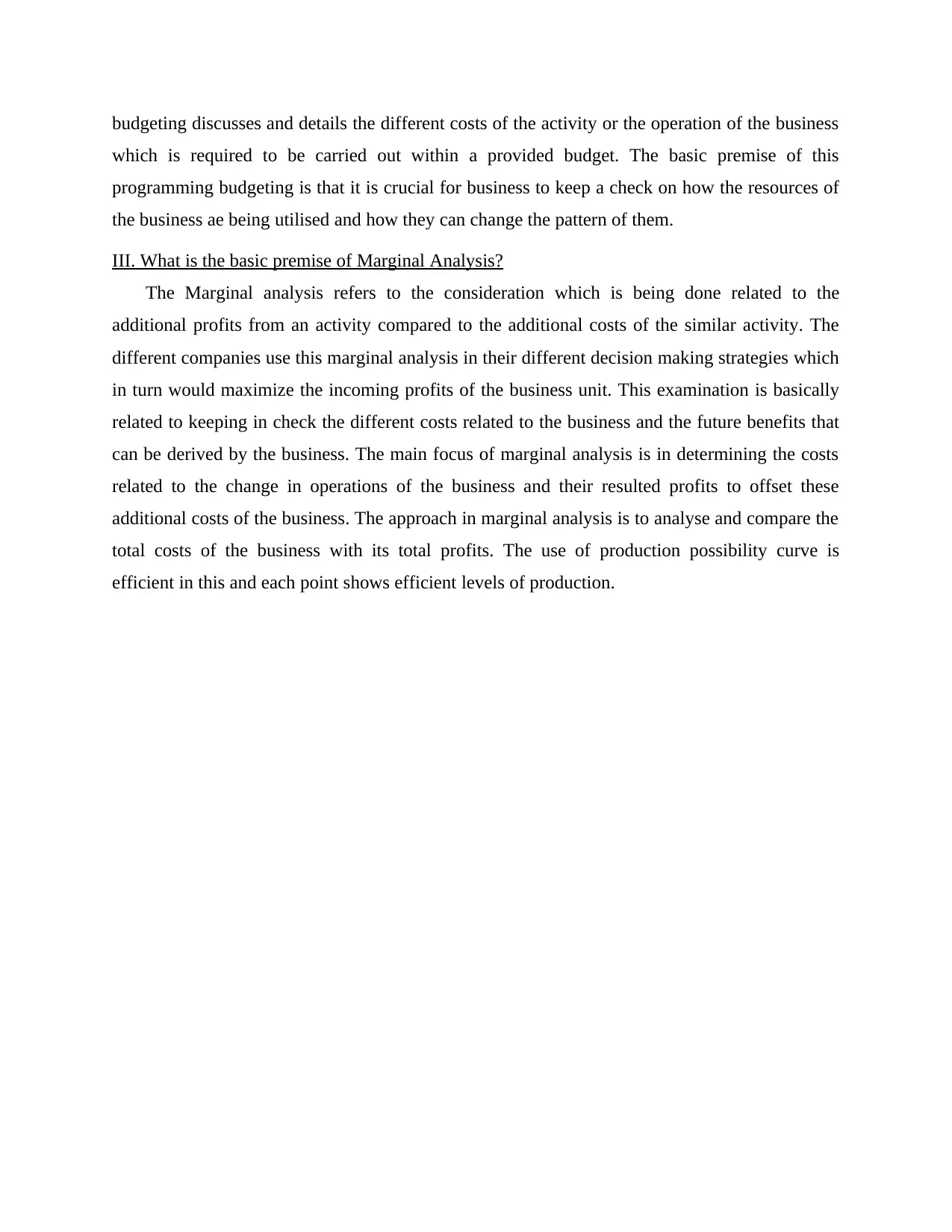
budgeting discusses and details the different costs of the activity or the operation of the business
which is required to be carried out within a provided budget. The basic premise of this
programming budgeting is that it is crucial for business to keep a check on how the resources of
the business ae being utilised and how they can change the pattern of them.
III. What is the basic premise of Marginal Analysis?
The Marginal analysis refers to the consideration which is being done related to the
additional profits from an activity compared to the additional costs of the similar activity. The
different companies use this marginal analysis in their different decision making strategies which
in turn would maximize the incoming profits of the business unit. This examination is basically
related to keeping in check the different costs related to the business and the future benefits that
can be derived by the business. The main focus of marginal analysis is in determining the costs
related to the change in operations of the business and their resulted profits to offset these
additional costs of the business. The approach in marginal analysis is to analyse and compare the
total costs of the business with its total profits. The use of production possibility curve is
efficient in this and each point shows efficient levels of production.
which is required to be carried out within a provided budget. The basic premise of this
programming budgeting is that it is crucial for business to keep a check on how the resources of
the business ae being utilised and how they can change the pattern of them.
III. What is the basic premise of Marginal Analysis?
The Marginal analysis refers to the consideration which is being done related to the
additional profits from an activity compared to the additional costs of the similar activity. The
different companies use this marginal analysis in their different decision making strategies which
in turn would maximize the incoming profits of the business unit. This examination is basically
related to keeping in check the different costs related to the business and the future benefits that
can be derived by the business. The main focus of marginal analysis is in determining the costs
related to the change in operations of the business and their resulted profits to offset these
additional costs of the business. The approach in marginal analysis is to analyse and compare the
total costs of the business with its total profits. The use of production possibility curve is
efficient in this and each point shows efficient levels of production.
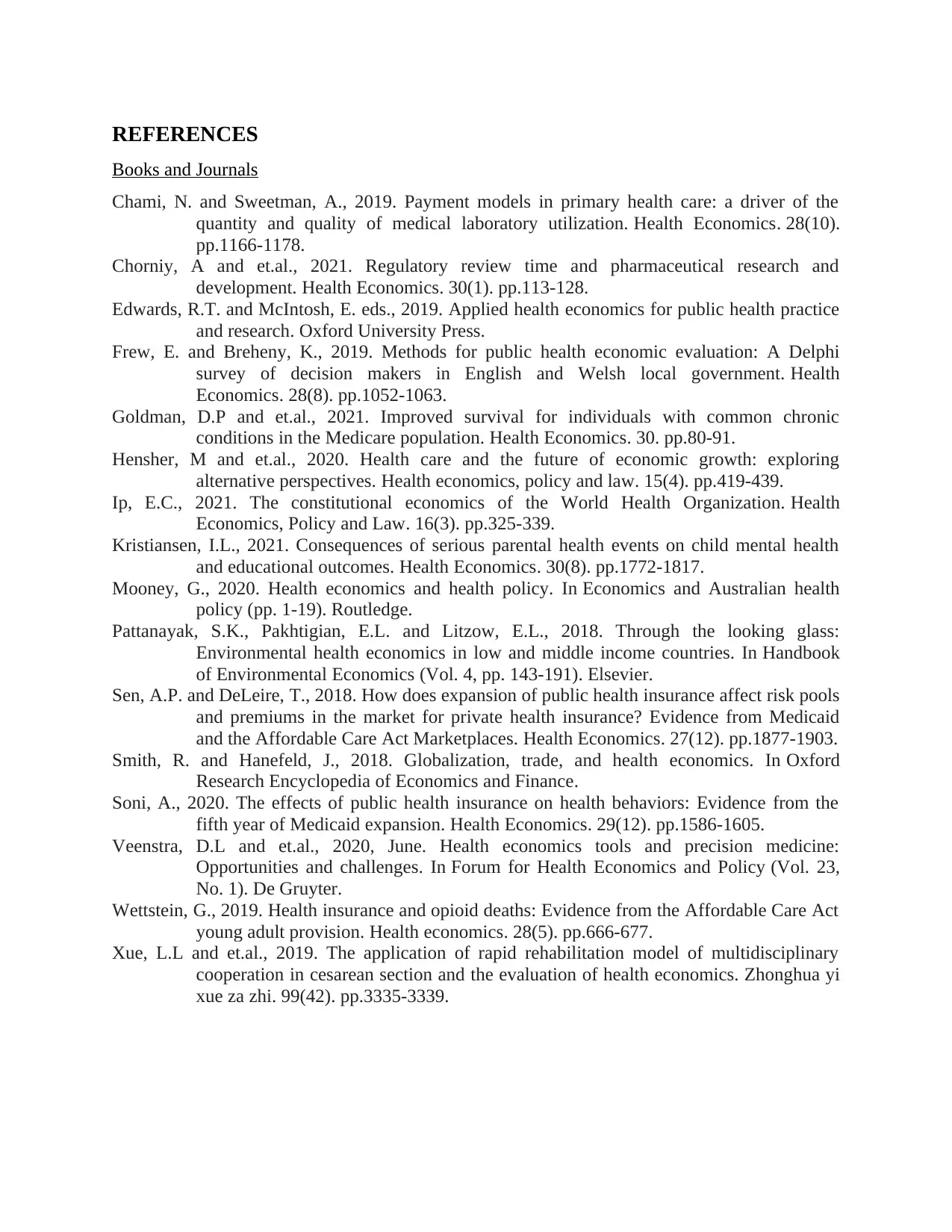
REFERENCES
Books and Journals
Chami, N. and Sweetman, A., 2019. Payment models in primary health care: a driver of the
quantity and quality of medical laboratory utilization. Health Economics. 28(10).
pp.1166-1178.
Chorniy, A and et.al., 2021. Regulatory review time and pharmaceutical research and
development. Health Economics. 30(1). pp.113-128.
Edwards, R.T. and McIntosh, E. eds., 2019. Applied health economics for public health practice
and research. Oxford University Press.
Frew, E. and Breheny, K., 2019. Methods for public health economic evaluation: A Delphi
survey of decision makers in English and Welsh local government. Health
Economics. 28(8). pp.1052-1063.
Goldman, D.P and et.al., 2021. Improved survival for individuals with common chronic
conditions in the Medicare population. Health Economics. 30. pp.80-91.
Hensher, M and et.al., 2020. Health care and the future of economic growth: exploring
alternative perspectives. Health economics, policy and law. 15(4). pp.419-439.
Ip, E.C., 2021. The constitutional economics of the World Health Organization. Health
Economics, Policy and Law. 16(3). pp.325-339.
Kristiansen, I.L., 2021. Consequences of serious parental health events on child mental health
and educational outcomes. Health Economics. 30(8). pp.1772-1817.
Mooney, G., 2020. Health economics and health policy. In Economics and Australian health
policy (pp. 1-19). Routledge.
Pattanayak, S.K., Pakhtigian, E.L. and Litzow, E.L., 2018. Through the looking glass:
Environmental health economics in low and middle income countries. In Handbook
of Environmental Economics (Vol. 4, pp. 143-191). Elsevier.
Sen, A.P. and DeLeire, T., 2018. How does expansion of public health insurance affect risk pools
and premiums in the market for private health insurance? Evidence from Medicaid
and the Affordable Care Act Marketplaces. Health Economics. 27(12). pp.1877-1903.
Smith, R. and Hanefeld, J., 2018. Globalization, trade, and health economics. In Oxford
Research Encyclopedia of Economics and Finance.
Soni, A., 2020. The effects of public health insurance on health behaviors: Evidence from the
fifth year of Medicaid expansion. Health Economics. 29(12). pp.1586-1605.
Veenstra, D.L and et.al., 2020, June. Health economics tools and precision medicine:
Opportunities and challenges. In Forum for Health Economics and Policy (Vol. 23,
No. 1). De Gruyter.
Wettstein, G., 2019. Health insurance and opioid deaths: Evidence from the Affordable Care Act
young adult provision. Health economics. 28(5). pp.666-677.
Xue, L.L and et.al., 2019. The application of rapid rehabilitation model of multidisciplinary
cooperation in cesarean section and the evaluation of health economics. Zhonghua yi
xue za zhi. 99(42). pp.3335-3339.
Books and Journals
Chami, N. and Sweetman, A., 2019. Payment models in primary health care: a driver of the
quantity and quality of medical laboratory utilization. Health Economics. 28(10).
pp.1166-1178.
Chorniy, A and et.al., 2021. Regulatory review time and pharmaceutical research and
development. Health Economics. 30(1). pp.113-128.
Edwards, R.T. and McIntosh, E. eds., 2019. Applied health economics for public health practice
and research. Oxford University Press.
Frew, E. and Breheny, K., 2019. Methods for public health economic evaluation: A Delphi
survey of decision makers in English and Welsh local government. Health
Economics. 28(8). pp.1052-1063.
Goldman, D.P and et.al., 2021. Improved survival for individuals with common chronic
conditions in the Medicare population. Health Economics. 30. pp.80-91.
Hensher, M and et.al., 2020. Health care and the future of economic growth: exploring
alternative perspectives. Health economics, policy and law. 15(4). pp.419-439.
Ip, E.C., 2021. The constitutional economics of the World Health Organization. Health
Economics, Policy and Law. 16(3). pp.325-339.
Kristiansen, I.L., 2021. Consequences of serious parental health events on child mental health
and educational outcomes. Health Economics. 30(8). pp.1772-1817.
Mooney, G., 2020. Health economics and health policy. In Economics and Australian health
policy (pp. 1-19). Routledge.
Pattanayak, S.K., Pakhtigian, E.L. and Litzow, E.L., 2018. Through the looking glass:
Environmental health economics in low and middle income countries. In Handbook
of Environmental Economics (Vol. 4, pp. 143-191). Elsevier.
Sen, A.P. and DeLeire, T., 2018. How does expansion of public health insurance affect risk pools
and premiums in the market for private health insurance? Evidence from Medicaid
and the Affordable Care Act Marketplaces. Health Economics. 27(12). pp.1877-1903.
Smith, R. and Hanefeld, J., 2018. Globalization, trade, and health economics. In Oxford
Research Encyclopedia of Economics and Finance.
Soni, A., 2020. The effects of public health insurance on health behaviors: Evidence from the
fifth year of Medicaid expansion. Health Economics. 29(12). pp.1586-1605.
Veenstra, D.L and et.al., 2020, June. Health economics tools and precision medicine:
Opportunities and challenges. In Forum for Health Economics and Policy (Vol. 23,
No. 1). De Gruyter.
Wettstein, G., 2019. Health insurance and opioid deaths: Evidence from the Affordable Care Act
young adult provision. Health economics. 28(5). pp.666-677.
Xue, L.L and et.al., 2019. The application of rapid rehabilitation model of multidisciplinary
cooperation in cesarean section and the evaluation of health economics. Zhonghua yi
xue za zhi. 99(42). pp.3335-3339.
1 out of 12
Related Documents
Your All-in-One AI-Powered Toolkit for Academic Success.
+13062052269
info@desklib.com
Available 24*7 on WhatsApp / Email
![[object Object]](/_next/static/media/star-bottom.7253800d.svg)
Unlock your academic potential
© 2024 | Zucol Services PVT LTD | All rights reserved.





